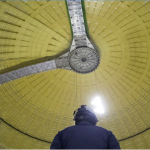Oil’s rout may have been an unexpected boon for the biggest buyers of liquefied natural gas, but its knock-on effects may come back to bite them.
That’s because more than a dozen proposed LNG export projects from the U.S. to Mozambique are at risk of being delayed or scrapped as crude careened to levels that make most of them unprofitable. If fewer of them come to fruition, that would ease a widening LNG supply glut later this decade and potentially lift prices amid breakneck demand growth in Asia.
The multibillion-dollar export terminals typically sell their output at a price linked to crude. While projects are financed based on long-term models, because they take years to build and then operate for decades, if oil and gas prices stay at current levels throughout the year, it could force backers and financial institutions to rethink their plans.
Almost 20 proposed export plants are vying for a shrinking pool of capital after a record number of terminals reached final investment decisions last year. Even before crude’s drop, developers were under pressure from a slump in global gas prices, milder winter temperatures and demand restraints from the coronavirus.
“With significant downward pressure on spot LNG prices and oil prices, it could be the double-whammy that really starts to make some projects seem uneconomic,” Jeff Moore, an analyst with S&P Global Platts, said in an email. “If oil prices stay low for much of this year, I would imagine it could have a material impact on supply projects looking to reach FID this year.”
Before oil’s recent crash, BloombergNEF had marked four projects as highly likely to reach FID in 2020, while another 15 were seen as potential candidates or “wildcards,” according to a report published last month. BNEF is currently reassessing the timeline for potential FIDs in light of the market crash and coronavirus outbreak.More FromBloomberg GreenOlder ESG Funds Outperform Their Newer Rivals in Market TumultItaly’s Coronavirus Lockdown Is Already Lowering Air PollutionThe Greening of a City Built on OilU.K. Wind-Farm U-Turn Avoids Possible Pitfall in London Court
“It has been: ‘times are tough now, but the world will need this LNG, so we can’t let these short-term fundamentals affect the longer-term strategic decisions’,” Angus Rodger, a Singapore-based research director at Wood Mackenzie Ltd., said in an interview earlier this week. “If we continue rattling at the bottom, it will have an impact at some stage on companies’ willingness to make large capital commitments.”
Most developers are looking to sell LNG at $8 per million British thermal units, which has become difficult under market prices, according to Trevor Sikorski, head of natural gas, coal and carbon at London-based industry consultant Energy Aspects Ltd. Brent crude’s forward curve shows oil hitting about $55 per barrel by 2029, a price level that isn’t profitable for any of the proposed LNG projects, except for a planned expansion in Qatar, according to Sanford C. Bernstein & Co.
On the flip side, fewer LNG projects taking a FID in 2020 and 2021 will likely translate into lower global supply between 2024 and 2027, Giles Farrer, research director at WoodMac, said Wednesday in a report.
A crowded field of competing U.S. projects could be the most at risk, as developers had already been struggling to attract buyers amid the ongoing trade war with China, the fastest-growing market for the super-chilled fuel. Without supply deals or portfolio players willing to agree to purchase potential exports, it is challenging for a project to clinch a final investment decision.
The oil collapse “in my mind is the nail in the coffin” for some U.S. LNG projects and will lead to delays for existing terminals looking to expand, said Madeline Jowdy, senior director of global gas and LNG for S&P Global Platts. Much of the industry pegged hopes for signing contracts on Chinese buyers, but they may have to rethink the Asian giant’s appetite for gas in the wake of the coronavirus, she said.
It will be “tougher” for U.S. LNG terminal developer Cheniere Energy Inc. to finalize contracts for an expansion at its Texas export terminal, Chief Executive Officer Jack Fusco said on a call with analysts last month. The Houston-based company, the U.S.’s largest exporter, won’t green-light its next project until contracts are in place.
Meanwhile, shares of Tellurian Inc., another U.S. developer, have tumbled after the company failed to finalize a key supply deal with a potential Indian customer late last month for its $29 billion Driftwood export project. The company was forced to slash almost 40% of its workforce as part of a cost-cutting move and a final investment decision could be delayed by at least a year.
The potential drop in supply “could be good news, as this ultimately will help bring the market into balance,” Sanford C. Bernstein analysts said Thursday in a report. “And the longer it takes for projects to be approved, the better the price recovery will ultimately be for the market.”
Futures for the Japan-Korea Marker, a benchmark for LNG delivered to northern Asia, are down about 50% over the last year to $3.140 per million Btu. Meanwhile, an LNG contract with a 12% slope to Brent crude is currently at about $3.93, compared with $8.27 in early January.
“Companies looking to sanction new investments, both large one and smaller ones, will be running them on a much lower scenario, at least in the short term,” said Woodmac’s Rodger. They will be making “decisions based on maybe lower oil price scenarios. In which case a lot of investments just won’t happen.”







